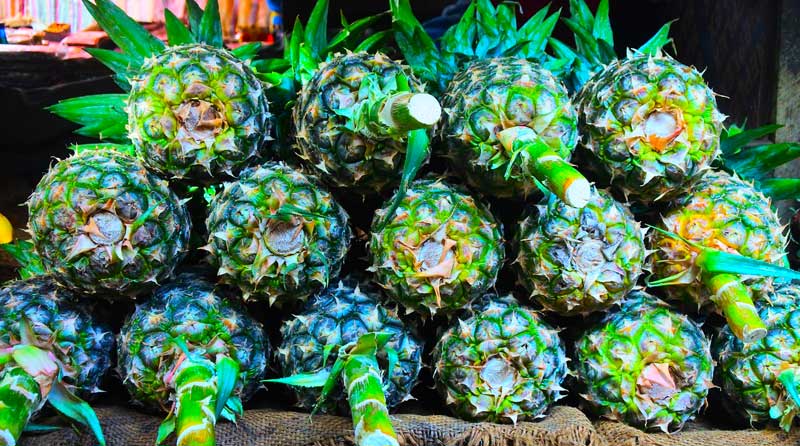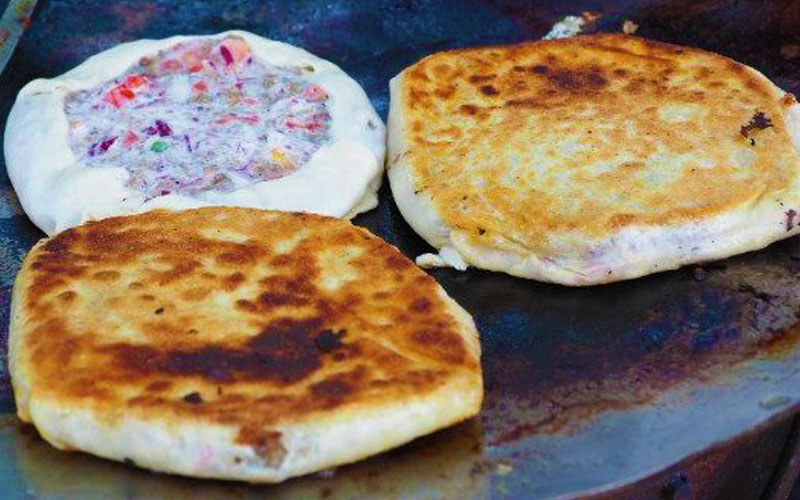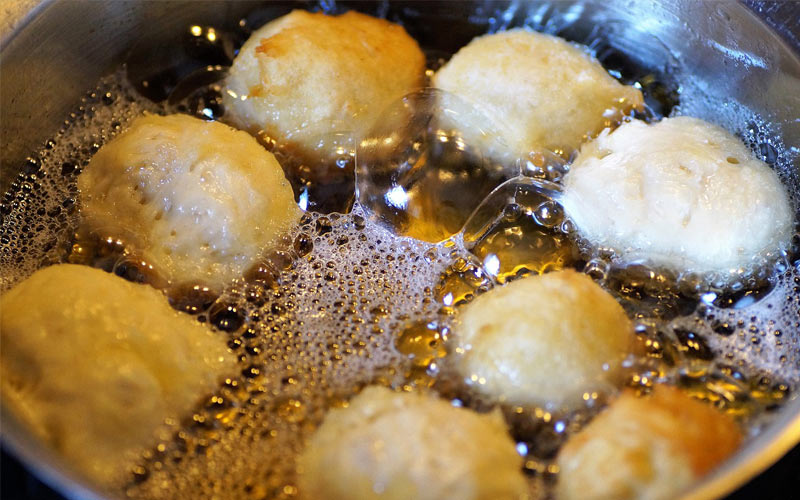Flavoured with its array of homegrown spices such as cloves, vanilla, saffron, cinnamon, nutmeg and black pepper Zanzibar is nicknamed the Spice Island.
Thanks to the abundant spices readily available on the island, the Zanzibar food is laden with unique and exotic flavours. Coupled with this, the mix of Indian, Arabic, Swahili and European cultures makes for some mouthwatering dishes.
My Quick Takeaways:
Exploring Zanzibar's culinary delights? Here are my favourite Zanzibar foods:
- Zanzibar Pizza: A unique street food, this is a savoury, greasy dough loaded with spices, tomatoes, onions, meat, and topped with cheese. It's wood-fired and folded into a loaded doughy square.
- Spice Cake: A famous dessert made from chocolate, cinnamon, nutmeg, and locally-grown cloves, embodying the island's rich spice heritage.
- Zanzibar Coffee: A staple drink, often cardamom-spiced Arabic coffee served without milk, available in numerous coffee shops and street vendors across the island.
- Mandazi (Zanzibar Doughnuts): Deep-fried dough balls, sweetened with or without cardamom, commonly found on street corners in Stone Town.
- Urojo Soup: A very spicy soup loaded with local ingredients, including mashed potato, bhajis, chilli, garlic, coconut, and raw mango, commonly served in the street markets of Stone Town.
Looking for more Zanzibar food? Let's dive into my ultimate guide.
Day tours in Zanzibar? Here are my top picks...
- Quad bike tour to a local village (4 hours)
- Stonetown food market and street food walking tour (3 hours)
- Zanzibar spice tour with traditional cooking lesson (3 hours)
- Rock restaurant and cave tour (6 hours)
- Private tour to Prison Island (3 hours)
Zanzibar Food
Most visitors descend upon the tropical Zanzibar Island to sunbathe on the beaches and try out the snorkelling and diving activities, but food lovers will delight in knowing that Zanzibar is a gastronomic destination and is ideal for culinary exploration.

Zanzibar Spice Farm Tour
Check out this awesome food and cooking tour from our recommended local partner
The price of food varies, but can be more expensive in high-end resorts. Overall, food is quite affordable with an average dinner costing anything from $7-$700 per person at a local restaurant.
For western meals, visitors can expect to pay anything from $5-$12 per person. Street food is a lot cheaper.
You can also expect to pay about $7 for a cocktail and about $3 for a beer. Alcohol is sold at hotels and resorts, but drinking is not commonplace among the locals.

The best way to experience the food on the island is to join a Zanzibar food and spices tour, which often feature a traditional Swahili Lunch.
Normally a tour accepts up to 12 people and takes about 3-4 hours for the entire tour and lunch.
Aside from the very popular and obvious Zanzibar pizza, the foods below are frequently eaten by locals in Zanzibar.

1. Zanzibar Pizza – Greasy Pancake
The two most popular local dishes include the spice cake and the ever famous Zanzibar pizza. The pizza is a combination of a few cultural flavours from the island, embodying the spirit of the island.
The pizza is basically a savoury, greasy dough loaded with spices, tomatoes, onions, meat and topped with cheese. It’s woodfired and then the corners are folded over into a loaded doughy square.

2. Spice Cake
Spice cake is a famous dessert in Zanzibar and is made from chocolate, cinnamon, nutmeg and aromatic locally-grown cloves. The cake is popular because it basically impersonates flavour combinations of favourite spices from Zanzibar Island.

3. Zanzibar Coffee
Technically not a dish, but a staple drink of Zanzibar. Its smell penetrates stone walls of the island towns, beach kiosks, restaurants, hotels and of course its down-to-earth coffee shops and street vendors.
There is such a plethora of great coffee shops one might wonder about sipping this drink day in and day out. Interestingly, the hotter the drink, the cooler one feels in this tropical heat – win-win, if you ask me!

Zanzibar Coffee House in Stone Town.
Venture out to any small coffee shop or even mobile stall to enjoy a very affordable cuppa of cardamom-spiced Arabic coffee, usually served without milk.
The best espresso type coffee is served at the notorious Mkunazini Street – the birthplace of Zanzibar Coffee House.
It’s a great spot for street photography too, with a number of quirky murals and locals sipping their drink of choice on any given afternoon.

4. Zanzibar Doughnuts – Mandazi
Pretty much on every corner of Stone Town, there is a food cart peppered with mandazi or small triangular doughnuts.
They are basic deep-friend dough balls, sweetened with or without cardamom.
My Pro Tip: Mukhy’s Café serves some of the fluffier kind of mandazi. It’s a perfect comfort snack and an easy one to try replicating at home. A party winner.

5. Zanzibar Polenta – Ugali Side Dish
Ugali is a traditional savoury side dish eaten by the locals in both Zanzibar and Tanzania, usually accompanying beef or vegetable meals.
It’s a staple food of the country and is made from maize. You make it by rolling cornmeal paste into a ball and then cooking it.
It’s a little bit like polenta and is otherwise known as pap.

6. Zanzibar Kebabs – Mishkaki
In East Africa, just as in any corner of the world with indulging street food culture Mishkaki is ridiculously popular and delicious in its variety.
It refers to barbecued skewers or kebabs of meat grilled over the fire. The meat used is normally steak, but you can find all kinds of skewers on offer across Stone Town markets.

7. Go-to-Seafood – Octopus
Octopus is widely consumed across the island and readily available. The oceans are full of delicacies, and octopus is a favourite.
From octopus coconut curry to grilled octopus, there are many ways the locals cook this seafood.

8. Very Spicy Urojo Soup
Urojo is commonly served on the streets of Zanzibar, particularly in the street markets of Stone Town.
It is a soup loaded with local ingredients and is very spicy. The heart of the soup is mashed potato and bhajis (fried vegetable snack).
Generally, the ingredients include chilli, garlic, coconut and raw delicious mango, also grown on the island.

9. Coconut Doughnuts – Vitumbua
Also a favourite in Zambia, vitumbua is a sweet snack of Zanzibar served on the streets and in the markets. These delectable treats are made from rice, coconut, sugar, yeast and spices such as cardamom.

10. Filling Biryani
Biryani is a dish typically served in India and the Middle East.
Because Zanzibar has both the Middle East and Indian influences, biryani has made its way into mainstream Zanzibar cuisine. It is now one of the most sought-after dishes to eat in the country.
Biryani is a rice dish jam-packed with flavour. The rice is laden with spices and then a protein such as chicken, goat or fish is added on the side.
The protein is made in a curry sauce and paired with the Biryani rice, which is always made separately from the curry.

11. Omelette with French Fries – Chips Mayai
Chips Mayai is basically a delicious omelette made from French fries but prepared slightly differently. In Swahili, Mayai means eggs.
Essentially, it’s French Fries in eggs served that’s normally served with a hot chilli sauce or side of salad. Chips Mayai is found on almost every street corner and in every restaurant.

12. Zanzibar Chocolate – Sesame Seed Nougat Bites
Rather misleadingly called, this Zanzibar chocolate is actually a sweet and savoury nougat bar made with toasted sesame seeds and thick honey.
Served as sticky bite-size diamond-shaped pieces, it could be lifted straight from any Middle Eastern baklava shop.
These are available around most markets, but they have wonderful stalls on the Forodhani Gardens’ market.

Zanzibar Street Food Tour
Check out this awesome street food tour from our recommended local partner
Tourist FAQs for Zanzibar Island
What is the best time of year to visit Zanzibar Island?
Zanzibar is an idyllic year-round destination, but many consider July through to September to be the best time of year to visit.
The dry season, from December to February, is also a popular time of year to visit. The wet season only lasts for three months, and even then it’s just short bursts of rain.
Don't forget to also check out my user-friendly map of Zanzibar to better orient yourself with this exotic paradise.

How many days do you need in Zanzibar?
A good amount of time to experience the beaches of Zanzibar, the culture of Stone Town and the food tours in Zanzibar, is about 7-10 days in total.
Three days could be allocated for cultural, food and shopping experiences in Stone Town alone, while the rest of the time can be spent in one area of the island or split between two regions.
How expensive is Zanzibar?
On average, tourists spend about $45 per day in Zanzibar. High-end Zanzibar hotels range from $250 per night, while holiday rentals are very cheap.
Visitors can rent an entire home for as little as $400 per night. A budget for mid-range travellers comes to roughly $650 for a week.
Private taxis for transportation are about $40. A guest house on a beach serving breakfast can cost anything from $40-$100 per night.
Read my guide to combined Tanzanian safaris and Zanzibar beach holidays for more info on typical costs of a beach holiday.
Day tours in Zanzibar? Here are my top picks...
- Quad bike tour to a local village (4 hours)
- Stonetown food market and street food walking tour (3 hours)
- Zanzibar spice tour with traditional cooking lesson (3 hours)
- Rock restaurant and cave tour (6 hours)
- Private tour to Prison Island (3 hours)
Is Zanzibar safe at night?
Zanzibar is one of the safest islands to travel to, and isn’t dangerous for tourists. Whenever travellers visit a new city, care should be taken with belongings though.
At night time, it’s less safe, and there are occasional muggings – particularly in the port area in Stone Town.
If walking around, visitors should walk in a group or organise a private taxi for transport. Visitors should always err on the side of caution when going out at night in a city.
Always keep valuables and expensive items out of sight. Solo female travellers can travel comfortably to Zanzibar, but should take extra care at night.

Stone Town at night.
Do I need a visa for Zanzibar?
Most European countries require a visa, but this can be obtained quite easily. Foreign nationals can apply for a visa in advance online.
Most European and US countries require a visa, whereas some African countries don’t. It’s always best to check the updated list on the official government website.
What language is spoken in Zanzibar?
Zanzibar and Tanzania’s official language is Swahili, but it is a multilingual country. English is also widely spoken in the bigger villages and towns.
There are several other languages spoken in smaller villages.
Day tours in Zanzibar? Here are my top picks...
- Quad bike tour to a local village (4 hours)
- Stonetown food market and street food walking tour (3 hours)
- Zanzibar spice tour with traditional cooking lesson (3 hours)
- Rock restaurant and cave tour (6 hours)
- Private tour to Prison Island (3 hours)
My Final Thoughts
And that's a wrap on the 12 best Zanzibar Food dishes! Expect an explosion of flavours and aromas when you taste the local cuisine on Tanzania's very own Spice Island.

Zanzibar is one of the best island that you can relax your mind